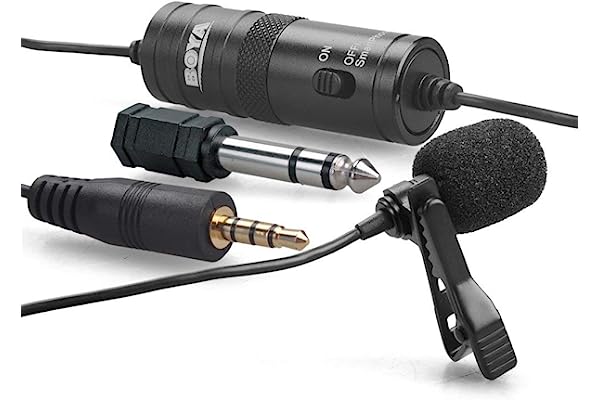Features
Boya BY-M1 Lavalier Microphone

- Clip-On Mic for Smartphone, DSLR Cameras,Camcorders, Audio Recorders, PC
- Omni directional condenser microphone
- High-quality condenser, ideal for video use
- Low handling noise
- Includes lapel clip, LR44 battery, foam windscreen, 1/4” adapter
RØDE NT1

- Groundbreaking studio condenser microphone that fuses the classic sound signature of the iconic NT1 with patented next-generation technology
- Connect to an audio interface or mixer via XLR, or plug directly into a computer via USB to record studio-grade sound in any setup – an all-in-one digital recording solution for the home or the studio
- Offers the classic warm, silky character, extremely low self-noise and high SPL handling capability that the original is revered for, perfect for a huge range of applications, from voiceovers and guitars to drums and piano
- Features RØDE’s ultra-low-noise, high-gain Revolution Preamp and high-resolution (up to 192kHz) analog-to-digital conversion for crystal-clear digital recordings
- Body machined from high-grade aluminium with nickel plating and military-grade ceramic coating, ensuring its ready to take on the rigours of recording day in, day out
Introduction
Are you looking for the perfect microphone to record audio for your next project? Whether you’re a musician, a podcaster, or a YouTuber, you’ll need to find the right microphone for the job. In this blog post, we’ll compare two popular microphones: the Boya BY-M1 Lavalier Microphone and the RØDE NT1 5th Generation Large-Diaphragm Studio Condenser Microphone. We’ll discuss their features, performance, and price to help you make an informed decision. So, let’s get started!
Features
The Boya BY-M1 Lavalier Microphone is a clip-on omnidirectional condenser microphone designed for use with smartphones, DSLR cameras, camcorders, audio recorders, and PCs. It has an omnidirectional pickup pattern that captures audio from all directions and a frequency response of 70Hz to 18kHz. It also features a 3.5mm TRS output that connects to most recording devices.
The RØDE NT1 5th Generation Large-Diaphragm Studio Condenser Microphone is a studio-grade microphone designed for music production, vocal recording, and podcasting. It features a large-diaphragm condenser capsule that captures audio with exceptional clarity and detail. It also has a frequency response of 20Hz to 20kHz, a -10dB pad, and a high-pass filter. It has both XLR and USB outputs, and comes with a shock mount and pop filter.
Performance
The Boya BY-M1 Lavalier Microphone is a great choice for recording audio on the go. Its omnidirectional pickup pattern makes it ideal for capturing audio from multiple directions, such as when recording a conversation or a panel discussion. It also has a wide frequency response, making it suitable for capturing a wide range of sounds.
The RØDE NT1 5th Generation Large-Diaphragm Studio Condenser Microphone is designed for studio-grade audio recording. Its large-diaphragm condenser capsule provides exceptional clarity and detail, making it perfect for recording vocals, instruments, and other sound sources. It also has a wide frequency response and a -10dB pad and high-pass filter for added flexibility.
Price
The Boya BY-M1 Lavalier Microphone is an affordable microphone, with prices starting at around $50. It’s a great choice for those on a budget who need a reliable microphone for recording audio on the go.
The RØDE NT1 5th Generation Large-Diaphragm Studio Condenser Microphone is a more expensive option, with prices starting at around $250. It’s a great choice for those who need a professional-grade microphone for studio recording.
Conclusion
The Boya BY-M1 Lavalier Microphone and the RØDE NT1 5th Generation Large-Diaphragm Studio Condenser Microphone are both excellent microphones. The Boya BY-M1 is a great choice for those on a budget who need a reliable microphone for recording audio on the go. The RØDE NT1 is a more expensive option, but it’s perfect for those who need a professional-grade microphone for studio recording.
No matter which microphone you choose, you can be sure that you’ll be getting a high-quality product that will provide you with excellent audio recording. So, take your time to compare the features, performance, and price of both microphones, and pick the one that best suits your needs.
Specifications / Attributes
| Feature | Boya BY-M1 Lavalier Microphone | RØDE NT1 |
|---|---|---|
| Batteries | 1 LR44 batteries required. | N/A |
| Batteries Included | No | N/A |
| Batteries Required | No | N/A |
| Battery cell composition | Alkaline | N/A |
| Brand | BOYA | N/A |
| Colour | N/A | Black |
| Compatible Devices | Smartphone,smartphones | Laptop, Personal Computer |
| Connector | N/A | USB, XLR Connector |
| Connector Type | Auxiliary | N/A |
| Date First Available | 13 August 2019 | 21 February 2023 |
| Hardware Platform | PC, Smartphone | Laptop |
| Includes AC Adapter | No | N/A |
| Includes Rechargeable Battery | No | N/A |
| Is discontinued by manufacturer | No | N/A |
| Item Model Number | BY-M1 | NT1 5th Gen |
| Item Weight | 86.2 g | 308 g |
| Manufacturer | BOYA | N/A |
| Material Type | Foam | N/A |
| Microphone format | Lavalier | N/A |
| Model | BY-M1 | N/A |
| Mounting Hardware | Microphone, Battery, User manual | N/A |
| Noise level | 74 dB | N/A |
| Part Number | BOYA | N/A |
| Power Source | Battery Powered | Corded Electric |
| Product dimensions | 10.11 x 7.7 x 5.11 cm; 86.18 Grams | 27.18 x 20.96 x 17.65 cm; 308 Grams |
| Signal-to-noise ratio (dB) | 74 dB | N/A |
| Special Features | Clip | N/A |
| Check the Best Deal Price Today | Check the Best Deal Price Today |







